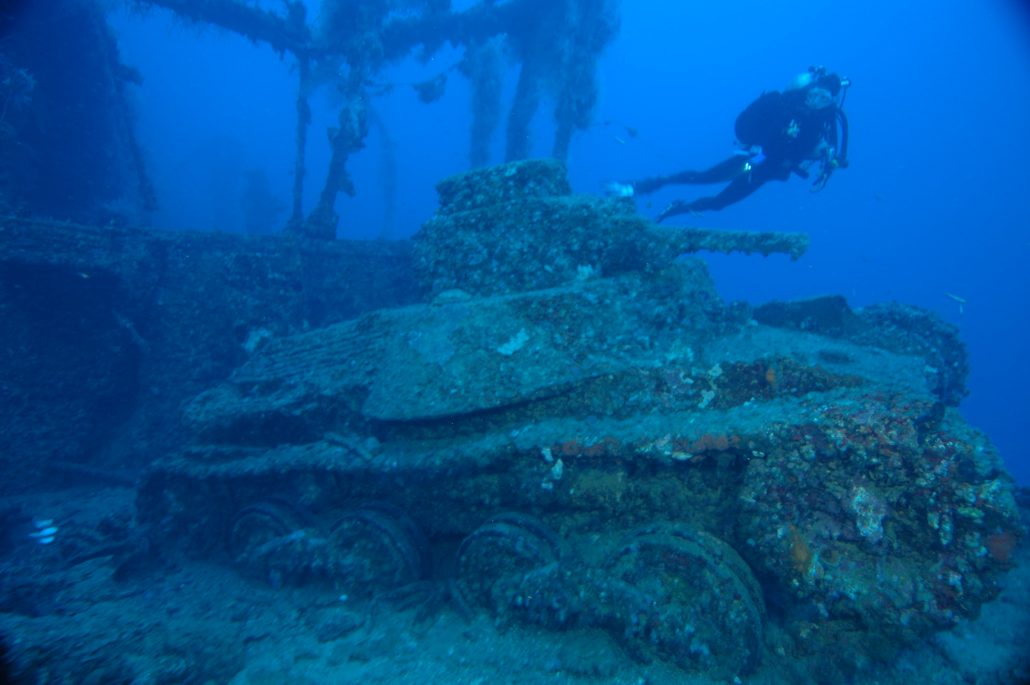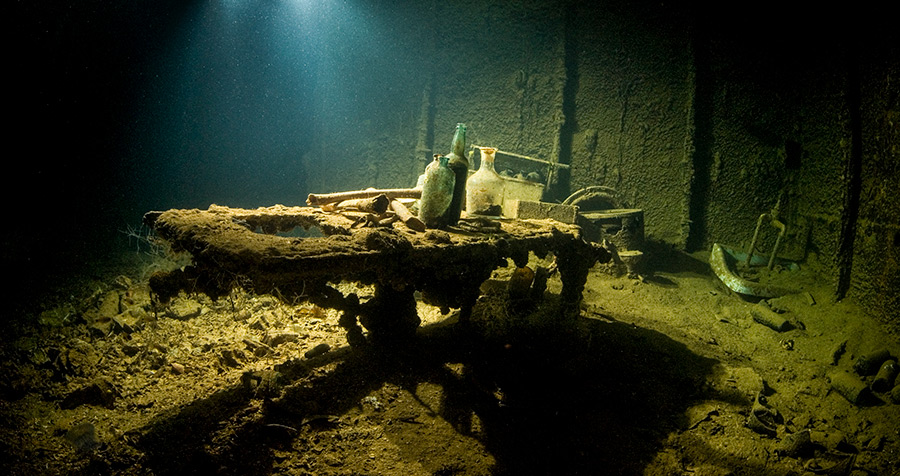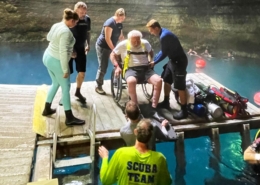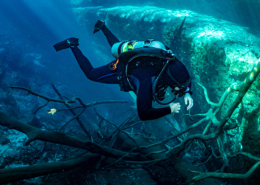Chuuk: W(Rec)k Tec Dives
Chuuk Lagoon in the Federated States of Micronesia offers both sport and tech divers a wide assortment of diving opportunities — often at the same site. Any of these can leave you feeling you just made the greatest dive ever. I know.
My name is Tarrant Dunford. I am a technical dive guide with over 500 dives in the lagoon. Here, in no particular order, are five wrecks which can be both fantastic sport and skillfully demanding technical dives.
Limits defined
Because this article frequently mentions sport and technical diving, it’s important to define both. A sport dive is any one in which divers:
- Do not exceed a depth of 40 m/130 ft
- Do not make dives requiring decompression
- Limit penetration to short swim-throughs and areas in which the exit is clearly visible
A technical dive is one which exceeds any of these limits. We also assume sport divers:
- Have Nitrox Diver certification and know how to determine MODs for deeper depths
- Have Deep Diver training or equivalent experience
- Know the importance of leaving artifacts untouched and in their original resting place
Fujikawa Maru
First up is one of Chuuk’s most famous wrecks, the Fujikawa Maru. This beautiful wreck lies off the southern side of Eten. Maximum depth is 36 m/120 ft of water and is pretty level. Her deck lies at roughly 18 m/60 ft. Divers consider her one of the prime jewels of the lagoon. It is easy to see why.
The dive is relatively shallow. Depths average 25 m/80 ft. The bow lies at 12 m/40 ft, making it great for younger divers. Overall, the relatively shallow depths make this wreck a good choice for divers with limited experience.
Sport divers will love the bow, anchor and anchor chain, and defensive gun. Breathtaking views make this area perfect for pictures. The bow gun’s informational plate is still attached. You can also find the telegraph.
The Fujikawa Maru has tons of wildlife, including schools of fish and reef and zebra sharks. Divers can even find marble rays off the sides on the sandy bottom. Coupled with loads of coral growth and anemones, this dive can be a photographer’s dream.
The cargo holds of Fujikawa carry a variety of objects. These range from 55-gallon fuel drums, flight masks, boots, ammo, rifles, a torpedo designed to be dropped by an airplane and even the planes themselves. The aircraft are Zekes (Mitsubishi A6M Zeros) and are in great shape. One has the number 39 still painted on its tail.
As a technical dive, the Fujikawa Maru is not overly difficult. It may cause some divers issues but, overall, is less challenging than some on this list. There are two areas beyond sport-diving limits which will interest technical divers.
First is the engine room. This is where a few divers may have issues as the stairwell is a bit narrow. However, once divers enter, they will see the rewards for their efforts. This area has a wooden phone booth with the telephone still intact. You can easily find a beautiful switchboard, gauges and the ship’s engine pistons.
The engineer’s room is full of spare parts, tools and some large machines. It is also the home of R2-D2, a beautifully intact compressor which makes for great pictures.
Other interesting features technical divers can check out include the rear deck gun, auxiliary steering, props and the fatal torpedo hole which sank the Fujikawa.
Heian Maru
Second on this list, and my personal favorite is the Heian Maru. The Heian lies off the north-western coast of Tonowas in the Combined Fleet Anchorage. The ship lies in 30 m/100 ft of water with an average depth of 23 m/75 ft. She lays on her port side and is not level. It is also the second largest in the lagoon at 155 m/512 ft long. You will see the name Heian Maru embossed on the bow in both Roman letters and Japanese Kanji.
You will want to make multiple dives on the Heian. There is so much to explore and see, it is impossible to do so all in one dive. It is a favorite of many past and present dive guides.

By Bill Downey
A good place to start is with the long lance torpedoes. The entrance to this area is shaped like a letterbox. After a short swim into the ship, you will see multiple long lance torpedoes in varying positions and stages of decay. After leaving the torpedo area, divers enter what I consider the best part of the wreck.
The extended superstructure is where photographers will adore the natural lighting. It is one of my favorite places to cruise. With beams of natural light, it produces a cathedral-like feeling. Here, in certain areas, artificial light is generally unnecessary. Within this area, it is easy to find beautifully preserved china, periscopes and a sense of tranquility.
If you like looking at a ship’s propellers, be sure to swing back and check out the twin prop sets at the stern. They are gorgeous. You can also find TOKYO written on the stern.
In the last cargo hold closest to the stern, in sport-diving depths, divers can find a medical kit, radios and bottles galore. It also has a flawless light bulb which looks like it was installed yesterday.
This wreck will answer the call for technical divers seeking to get rust on their gear. With the right guide and route, it is possible to spend over an hour inside this wreck. You’ll travel from bow to stern, seeing little to no sunlight. Tech divers will see everything sport divers can as well as enough content to write a separate article on this wreck alone.
The engine room, for example, is perfect for technical divers. The lower levels have fine silt covering the gauges, pipes, valves and indicator lights. There are parts which usually have a thick, eerie “wreck fog” floating around them.
There are many crew quarter areas. All are worth exploring. My favorite are the wooden bunk beds. The wood room partitions are still standing. Some are charred from the fires which helped sink the ship. Nearly all of the bunk rooms have bathrooms filled with white tile, sinks, tubs, showers and toilets. These areas are difficult to find and easily silted out, but worth the trouble.
This wreck has many gems which I encourage technical divers to find. There is a room with shackles, which I believe was a prisoner area on board the ship. Other unique sights include a barber shop complete with a chair, a pair of turtle skeletons, rooms full of burnt wood and, if you are lucky, you can still find books.
Tight pockets and corridors litter this wreck. Some are filled with china, others with medicine still floating around in their jars. There are a medical area and kitchen. Tech divers could spend hours diving this wreck multiple times and still not see it all.
Hoki Maru
Third on the list is the Hoki Maru. This wreck lies off the southwestern coast of Tonowas in the Fourth Fleet Anchorage. She lies in about 53 m/175 ft of water. The Hoki was blown in half when Task Force 58 bombed Truk Lagoon and hit the aviation gas it carried. As a result, there is only half a ship to explore. The other half was lost to the explosion.
This is the deepest wreck on the list, with only a few parts accessible to sport divers. The Hoki lies on an even keel. The deck is just below 30 m/100 ft. Parts creep up to shallower depths of about 18 m/60 ft. The props are at roughly 49 m/160 ft.
Sport divers should first head to is the last cargo hold. This will take them to the maximum depth for sport diving, but it is well worth it. This cargo hold is full of trucks, tractors and a few steamrollers. There is even a bulldozer threatening to fall to the deeper decks below. It is easy to spend all of your allotted bottom time here, but I urge you to save some for another spot or two.
At roughly 33 m/110 ft, the rear steering quarter is a quick swim through and worth a look, especially if this is your first time on the Hoki. In this area of the ship, you can easily find gears, cogs and a closet full of ammunition.
Another area which sport divers will enjoy is the explosion area. You can look over the area of the Hoki Maru where the explosion happened and try to take it all in. The ship looks like it was peeled open like an orange. You can maintain an average depth of about 18 m/60 ft. Below you will see at the twisted metal and the sidewalls which just fell away from the rest of the ship.
Tech divers will have a real blast on this wreck. The propellers, at about 49 m/160 ft, are incredibly photogenic. The Hoki had two props. Each blade is easily the size of a diver and amazing to see. If divers stick to the port side of the ship after passing the props, they can find an entrance through a torpedo hole. This leads into the hold with all of the trucks.
Once they have had their fill of trucks and tractors, the next cargo hold is the perfect place to inspect. It is full of airplane parts on the tween deck. Below this, divers with a keen eye can spot small aerial bombs and ammunition hidden among the muck and silt.
Within the same cargo hold, a tight path leads down the starboard side of the ship. Here divers can find all sorts of electrical equipment. Another quick turn or two will lead to a room full of bottles.
Technical divers who are engine room junkies will want to see this one. It is a bit of a squeeze but is one of my favorite engine rooms in the lagoon. This is because so few people go into it.
Nippo Maru
Next up is the Nippo Maru. She lies off the western coast of Tonowas, in the Fourth Fleet Anchorage. The seafloor lies at roughly 45 m/150 ft. Three hits from 225 kg/500 lb bombs sank the Nippo. She then slid down an underwater hill. The wreck is fairly even-keeled with a slight list to port.
This is a wonderful wreck and worth a few dives. Depths will limit sport divers to the deck and superstructure. Technical divers can get in good penetrations and see some killer sights.
Sport divers can check out a few howitzers sitting on the decks just behind the extended superstructure. There are several of these on the deck of the Nippo but do not spend too much time here as there is much more to see.
The wheelhouse of the Nippo is among the most photographed in the lagoon. With the large windows, helm and telegraph it is easy to see why. This area will be the shallowest portion of the wreck at about 21 m/70 ft. The next area is one of the main reasons sport divers love this wreck so much.

By Bill Downey
On the port side at 36 m/118 ft, you can find a Type 95 Ha-Go light battle tank suns gun. Divers can spend several minutes looking at and taking pictures of this tank. This usually is the highlight for most sport divers.
A little further up there is a truck chassis. There is another one on the ocean floor, just beyond sport diving depths. It’s not uncommon to see lionfish hanging around this area, so keep an eye out.
In the midship cargo hold near the trucks, divers can find gas masks and ammunition. The gas masks are in fairly good shape and strewn about the cargo hold. The ammo comes in a wide variety of sizes from rifle rounds and .50 caliber, up to shells for the bow guns which used to be part of the ship.
Technical divers will see much more on this wreck. The artifacts you can find on the Nippo are incredible and worth the decompression.
The staircase leading down to the engine room is amazing and rather unique. It spirals down in a squared-off fashion. At 45 m/150 ft, the ambient light you see when looking back up towards the pitched engine room roof is a sight to behold. The lower levels of the engine room are also breathtaking and roomy.
The hold aft of the engine room has bottles of all kinds. Beer bottles littering the floor and medicine bottles floating in the between decks. If you know where to look, you can find scientific equipment like Petri dishes, beakers, measuring devices and even an encrusted microscope sitting out in the open.
The extended superstructure has crew quarters, galleys, bathrooms and a few oddly placed bombs. Tech divers can make their way through the passageways and out the other side or up to the wheelhouse.
In the focsel of the Nippo, technical divers can find paper with writing still on it and small, beautiful, blue glass jars. There are also a few fountain pens laying around, with accompanying ink jars lying in the silt.
Shinkoku Maru
Last up is the Shinkoku Maru. This wreck lies near the islands of Udot and Param. She sits in 38 m/125 ft of water, settled even-keeled on the bottom. It is on most visitors’ “must dive” list.
It is easy to see why, too. With relatively shallow depths and plenty of wildlife, sport divers fall in love quickly. Its enormous engine room and penetrations help explain why many technical divers also enjoy this site.
If sport divers are not already addicted to wreck diving, then this may be the wreck which does them in. It has swim throughs which will make you think you are doing full penetrations, an incredible amount of wildlife and coral, and depths allowing for reasonable dive times.
The upper levels of the engine room have direct access to open water through the vented roof. This allows for an abundance of ambient light to come streaming in. There is a beautiful fuel transfer pump at 30 m/100 ft. Also at this depth are a few rooms into which divers can poke their heads before heading out and moving towards the bow.
Unfortunately, the superstructure began collapsing in 2018 due to age. However, the lower level allows for easy swim-throughs. On this level, divers find bathrooms with urinals, sinks and toilets. There is a washroom with white tiles and a surgical table with human remains. This area is sure to leave an impact on divers.
The entire ship is overgrown with coral and explodes with wildlife. Divers can take this in while swimming outside the ship. Large snappers, schools of jacks and clownfish are common, as well as several sharks and rays. It is easy for divers to forget they are on a wreck.

By Bill Downey
The deck gun is at about 18 m/60 ft. It is nearly unrecognizable and easily mistaken for a coral formation. This area is an amazing place to spend time just soaking in the sights and the decay. In the area below the deck gun is an easy swim through. Ambient light can make it look almost church-like in this small area.
Technical divers will spend a lot of time in the guts of this ship. She is big and beautiful, easily navigated once inside. Divers can spend 45 minutes or more in just the back third of the ship.
You can access the lower levels of the engine room through a bomb hole at 36 m/120 ft on the port side. Once inside the engine room, there is much to explore. These range from the switchboard, to the pistons of the engine, the prop shaft and even the boilers in the back room. There are bricks with Japanese Kanji stamped in them.
In the upper level of the engine room is at 30 m/100 ft. Here you can find the engineer’s room. The room is full of large machinery, spare parts and tools. This room silts easily, but there are many cool sights and artifacts to see. On the other side of the engineer’s room are a few additional rooms worth seeing.
Surrounding the engine room, technical divers can find immaculate bathrooms, crew quarters, spare prop blades, a wrench the size of a full-grown man. There are also china, light bulbs, door handles and plenty of large bottles.
From this area, technical divers can head to the bow taking in the sights of the wildlife. Just before the superstructure, there is the pump room. The entrance may be tight. However, once inside ambient light streaming through all the stairs and ladders can make the gauges and pipes dance.
There is one more place for technical divers near the front of the ship. I call this final area the forward cargo area, though I’m not sure if this is its proper name. Here you can find all kinds of artifacts. It is one of my favorite places to look for them. Here I’ve discovered inkwells, jars of shoe polish, porcelain caps, bottles of various types and rooms separated by wooden dividers. I am sure there is more!
Whether you are a sport or technical diver, the wrecks in Chuuk can challenge you while also offering one of the best experiences of your diving career. There are, of course, other dives in the lagoon which lend themselves to both sport and technical dives.

By Bill Downey
I chose these because they are my personal favorites or ones which divers request the most. Honorable mentions should also go to the Hoyo Maru, I-169, Kensho Maru, Kyosumi Maru, Momokawa Maru, Unkai Maru No. 6, and the Yamagiri Maru. Had I included these, this would end up being a book and not an article. If you’re interested in learning more about the history of Truk I would highly suggest hoping over to this article written by Aron Arngrimsson another highly experienced Truk diver.















Hinterlasse einen Kommentar
An der Diskussion beteiligen?Hinterlasse uns deinen Kommentar!